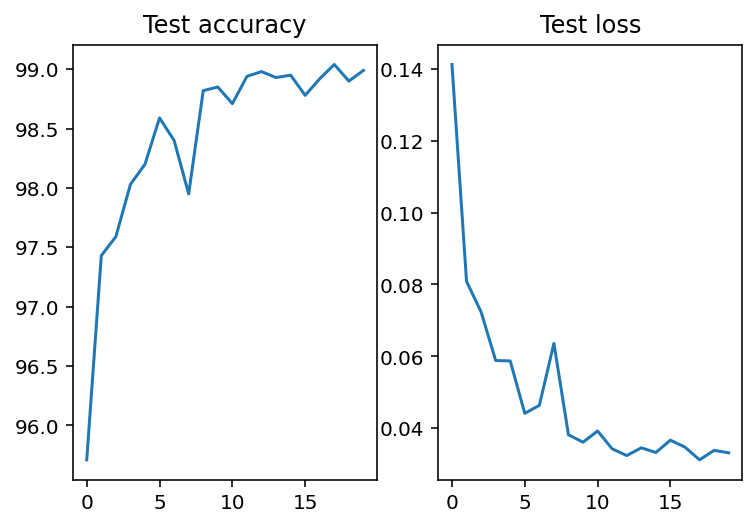Differentially private convolutional neural network on MNIST.#
A large portion of this code is forked from the differentially private SGD example in the JAX repo.
Differentially Private Stochastic Gradient Descent requires clipping the per-example parameter gradients, which is non-trivial to implement efficiently for convolutional neural networks. The JAX XLA compiler shines in this setting by optimizing the minibatch-vectorized computation for convolutional architectures. Train time takes a few seconds per epoch on a commodity GPU.
import warnings
import dp_accounting
import jax
import jax.numpy as jnp
from optax import contrib
from optax import losses
import optax
from jax.example_libraries import stax
import tensorflow as tf
import tensorflow_datasets as tfds
import matplotlib.pyplot as plt
# Shows on which platform JAX is running.
print("JAX running on", jax.devices()[0].platform.upper())
JAX running on GPU
This table contains hyperparameters and the corresponding expected test accuracy.
DPSGD |
LEARNING_RATE |
NOISE_MULTIPLIER |
L2_NORM_CLIP |
BATCH_SIZE |
NUM_EPOCHS |
DELTA |
FINAL TEST ACCURACY |
|---|---|---|---|---|---|---|---|
False |
0.1 |
NA |
NA |
256 |
20 |
NA |
~99% |
True |
0.25 |
1.3 |
1.5 |
256 |
15 |
1e-5 |
~95% |
True |
0.15 |
1.1 |
1.0 |
256 |
60 |
1e-5 |
~96.6% |
True |
0.25 |
0.7 |
1.5 |
256 |
45 |
1e-5 |
~97% |
# @markdown Whether to use DP-SGD or vanilla SGD:
DPSGD = True # @param{type:"boolean"}
# @markdown Learning rate for the optimizer:
LEARNING_RATE = 0.25 # @param{type:"number"}
# @markdown Noise multiplier for DP-SGD optimizer:
NOISE_MULTIPLIER = 1.3 # @param{type:"number"}
# @markdown L2 norm clip:
L2_NORM_CLIP = 1.5 # @param{type:"number"}
# @markdown Number of samples in each batch:
BATCH_SIZE = 256 # @param{type:"integer"}
# @markdown Number of epochs:
NUM_EPOCHS = 15 # @param{type:"integer"}
# @markdown Probability of information leakage:
DELTA = 1e-5 # @param{type:"number"}
CIFAR10 and CIFAR100 are composed of 32x32 images with 3 channels (RGB). We’ll now load the dataset using tensorflow_datasets and display a few of the first samples.
(train_loader, test_loader), info = tfds.load(
"mnist", split=["train", "test"], as_supervised=True, with_info=True
)
min_max_rgb = lambda image, label: (tf.cast(image, tf.float32) / 255., label)
train_loader = train_loader.map(min_max_rgb)
test_loader = test_loader.map(min_max_rgb)
train_loader_batched = train_loader.shuffle(
buffer_size=10_000, reshuffle_each_iteration=True
).batch(BATCH_SIZE, drop_remainder=True)
NUM_EXAMPLES = info.splits["test"].num_examples
test_batch = next(test_loader.batch(NUM_EXAMPLES, drop_remainder=True).as_numpy_iterator())
init_random_params, predict = stax.serial(
stax.Conv(16, (8, 8), padding="SAME", strides=(2, 2)),
stax.Relu,
stax.MaxPool((2, 2), (1, 1)),
stax.Conv(32, (4, 4), padding="VALID", strides=(2, 2)),
stax.Relu,
stax.MaxPool((2, 2), (1, 1)),
stax.Flatten,
stax.Dense(32),
stax.Relu,
stax.Dense(10),
)
This function computes the privacy parameter epsilon for the given number of steps and probability of information leakage DELTA.
def compute_epsilon(steps):
if NUM_EXAMPLES * DELTA > 1.:
warnings.warn("Your delta might be too high.")
q = BATCH_SIZE / float(NUM_EXAMPLES)
orders = list(jnp.linspace(1.1, 10.9, 99)) + list(range(11, 64))
accountant = dp_accounting.rdp.RdpAccountant(orders)
accountant.compose(dp_accounting.PoissonSampledDpEvent(
q, dp_accounting.GaussianDpEvent(NOISE_MULTIPLIER)), steps)
return accountant.get_epsilon(DELTA)
@jax.jit
def loss_fn(params, batch):
images, labels = batch
logits = predict(params, images)
return losses.softmax_cross_entropy_with_integer_labels(logits, labels).mean(), logits
@jax.jit
def test_step(params, batch):
images, labels = batch
logits = predict(params, images)
loss = losses.softmax_cross_entropy_with_integer_labels(logits, labels).mean()
accuracy = (logits.argmax(1) == labels).mean()
return loss, accuracy * 100
if DPSGD:
tx = contrib.dpsgd(
learning_rate=LEARNING_RATE, l2_norm_clip=L2_NORM_CLIP,
noise_multiplier=NOISE_MULTIPLIER, seed=1337)
else:
tx = optax.sgd(learning_rate=LEARNING_RATE)
_, params = init_random_params(jax.random.PRNGKey(1337), (-1, 28, 28, 1))
opt_state = tx.init(params)
@jax.jit
def train_step(params, opt_state, batch):
grad_fn = jax.grad(loss_fn, has_aux=True)
if DPSGD:
# Inserts a dimension in axis 1 to use jax.vmap over the batch.
batch = jax.tree_util.tree_map(lambda x: x[:, None], batch)
# Uses jax.vmap across the batch to extract per-example gradients.
grad_fn = jax.vmap(grad_fn, in_axes=(None, 0))
grads, _ = grad_fn(params, batch)
updates, new_opt_state = tx.update(grads, opt_state, params)
new_params = optax.apply_updates(params, updates)
return new_params, new_opt_state
accuracy, loss, epsilon = [], [], []
for epoch in range(NUM_EPOCHS):
for batch in train_loader_batched.as_numpy_iterator():
params, opt_state = train_step(params, opt_state, batch)
# Evaluates test accuracy.
test_loss, test_acc = test_step(params, test_batch)
accuracy.append(test_acc)
loss.append(test_loss)
print(f"Epoch {epoch + 1}/{NUM_EPOCHS}, test accuracy: {test_acc}")
#
if DPSGD:
steps = (1 + epoch) * NUM_EXAMPLES // BATCH_SIZE
eps = compute_epsilon(steps)
epsilon.append(eps)
if DPSGD:
_, axs = plt.subplots(ncols=3, figsize=(9, 3))
else:
_, axs = plt.subplots(ncols=2, figsize=(6, 3))
axs[0].plot(accuracy)
axs[0].set_title("Test accuracy")
axs[1].plot(loss)
axs[1].set_title("Test loss")
if DPSGD:
axs[2].plot(epsilon)
axs[2].set_title("Epsilon")
plt.tight_layout()
print(f'Final accuracy: {accuracy[-1]}')
Array(98.99, dtype=float32)
